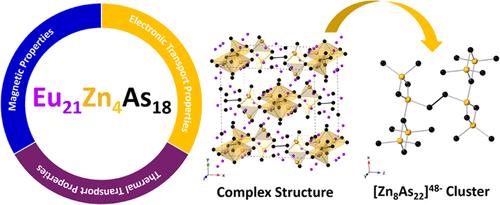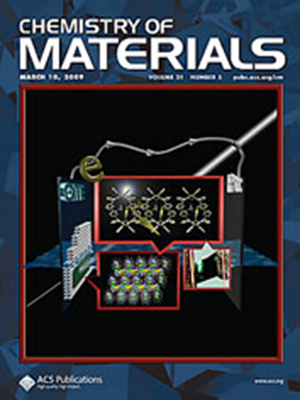Magnetism and Thermoelectric Properties of the Zintl Semiconductor: Eu21Zn4As18
IF 7.2
2区 材料科学
Q2 CHEMISTRY, PHYSICAL
引用次数: 0
Abstract
Compositional diversity and intriguing structural features have made Zintl phases excellent candidates as thermoelectric materials. Zintl phase with 21-4-18 composition has shown high thermoelectric performance in the mid- to high-temperature ranges. The complex crystal structure and favorable transport properties of these compounds indicate the potential for high thermoelectric efficiency. Arsenic-based Eu21Zn4As18, belonging to the Ca21Mn4Sb18 structure type, exhibits a semiconductor-like p-type transport behavior and has a calculated band gap of 0.49 eV. The compound is paramagnetic at high temperatures, with an antiferromagnetic transition occurring at TN = ∼10 K. The moment obtained from the Curie–Weiss data fit aligns with Eu2+ ions. At the same time, the field-dependent measurement at 2 K indicates complex magnetic ordering with a saturation moment consistent with Eu2+ ions. Pristine Eu21Zn4As18 exhibits an ultralow lattice thermal conductivity of 0.40 W m–1 K–1 at 873 K. Electronic transport properties measurement shows evidence of bipolar conduction across much of the measured temperature range (450–780 K). However, the Seebeck coefficient remains extremely high (>440 μV K–1) across this range, indicating the potential for high zT if an appropriate dopant is found. This work represents the first report on the temperature-dependent thermal conductivity, Seebeck coefficient, and thermoelectric efficiency of the arsenic-containing Zintl phase with 21-4-18 composition, showcasing its promise for further optimization of the thermoelectric performance.

Zintl 半导体的磁性和热电特性:Eu21Zn4As18
成分的多样性和奇妙的结构特征使 Zintl 相成为热电材料的绝佳候选材料。成分为 21-4-18 的 Zintl 相在中高温范围内显示出较高的热电性能。这些化合物复杂的晶体结构和良好的传输特性表明其具有提高热电效率的潜力。砷基 Eu21Zn4As18 属于 Ca21Mn4Sb18 结构类型,具有类似半导体的 p 型输运行为,计算带隙为 0.49 eV。该化合物在高温下具有顺磁性,在 TN = ∼10 K 时发生反铁磁性转变,居里-魏斯数据拟合得到的矩与 Eu2+ 离子一致。同时,在 2 K 条件下进行的磁场相关测量显示了复杂的磁有序性,其饱和磁矩与 Eu2+ 离子一致。原始 Eu21Zn4As18 在 873 K 时显示出 0.40 W m-1 K-1 的超低晶格热导率。电子传输特性测量显示,在大部分测量温度范围(450-780 K)内都存在双极传导的证据。然而,在整个温度范围内,塞贝克系数仍然非常高(440 μV K-1),这表明如果找到合适的掺杂剂,就有可能实现高 zT。这项研究首次报道了成分为 21-4-18 的含砷 Zintl 相随温度变化的热导率、塞贝克系数和热电效率,展示了其进一步优化热电性能的前景。
本文章由计算机程序翻译,如有差异,请以英文原文为准。
求助全文
约1分钟内获得全文
求助全文
来源期刊

Chemistry of Materials
工程技术-材料科学:综合
CiteScore
14.10
自引率
5.80%
发文量
929
审稿时长
1.5 months
期刊介绍:
The journal Chemistry of Materials focuses on publishing original research at the intersection of materials science and chemistry. The studies published in the journal involve chemistry as a prominent component and explore topics such as the design, synthesis, characterization, processing, understanding, and application of functional or potentially functional materials. The journal covers various areas of interest, including inorganic and organic solid-state chemistry, nanomaterials, biomaterials, thin films and polymers, and composite/hybrid materials. The journal particularly seeks papers that highlight the creation or development of innovative materials with novel optical, electrical, magnetic, catalytic, or mechanical properties. It is essential that manuscripts on these topics have a primary focus on the chemistry of materials and represent a significant advancement compared to prior research. Before external reviews are sought, submitted manuscripts undergo a review process by a minimum of two editors to ensure their appropriateness for the journal and the presence of sufficient evidence of a significant advance that will be of broad interest to the materials chemistry community.
 求助内容:
求助内容: 应助结果提醒方式:
应助结果提醒方式:


